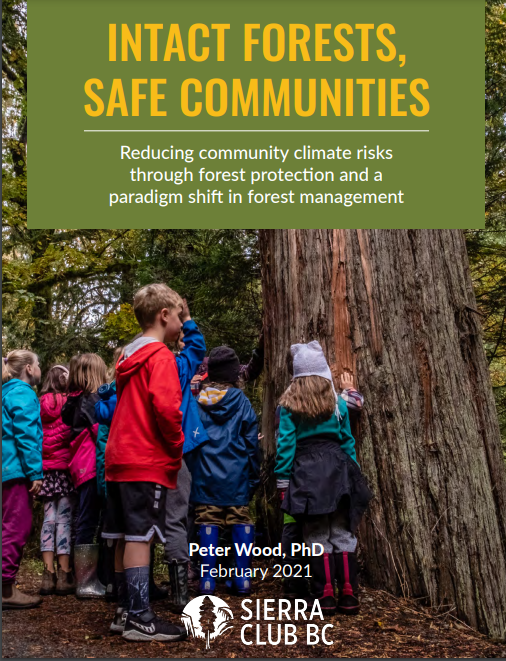Article /
Intact Forests, Safe Communities: Reducing Community Climate Risks through Forest Protection and a Paradigm Shift in Forest Management

Executive Summary
This resource was submitted by the Climate Risk Institute for use by the CanAdapt Climate Change Adaptation Community of Practice.
This article is an abridged version of the original text, which can be downloaded from the right-hand column. Please access the original text for more detail, research purposes, full references, or to quote text.
B.C.’s Strategic Climate Risk Assessment identifies 15 climate risks, several of which have the potential to create catastrophic impacts for B.C.’s communities. Overall, the assessment found that the greatest climate-related risks were severe wildfires, seasonal water shortages, and heat wave events. It also found that events such as severe river flooding were of “high consequence,” though less likely to occur.
There is a large body of scientific literature that documents the impact that industrial logging has on the severity and frequency of many of these events, yet the Assessment did not consider this information. This presents a major blind spot that could undermine the assessment’s findings and the effectiveness of the Province’s response in defending communities from worsening climate impacts.
This report attempts to address this gap in order to understand the role that forests in B.C. can play in either mitigating or exacerbating those risks, depending on how we manage them. It finds that nine of these risks are substantially affected by forest management, some of which could have catastrophic consequences for the health and safety of local communities.
The climate risks that are most affected by forest management include:
- Long-term water shortage
- Seasonal water shortage
- Riverine flooding
- Moderate flooding
- Extreme precipitation and landslide
- Severe wildfire season
- Heatwave
- Loss of forest resources
- Reduction in ecosystem connectivity
Just as climate change is expected to generate more extreme weather, intensive forest management, namely clearcutting, creates extreme conditions locally and at the landscape level. Clearcutting increases the frequency and intensity of forest fires, due to the significant proportion of dead biomass left behind, sun-exposed and flammable, and the extensive network of roads involved that increases the likelihood of humancaused ignition. Younger trees are extremely flammable due to dense spacing, thin bark, and low-hanging branches. They are also more susceptible to insect outbreaks, leading to dead standing trees that are susceptible to fire.
Clearcut logging disrupts local hydrology, increasing the risk of flooding at peak periods, but also resulting in higher peak temperatures and periods of drought. Roots of stumps begin to decay, losing their grip on soil, causing erosion and water turbidity, slope instability and increasing the likelihood of landslides.
In contrast, old intact forests act as a moderating influence on the landscape, creating their own microclimate that is cooler and wetter year-round. The shade they provide allows for the development of a rich understory and soil development, which acts as a sponge, absorbing and releasing water slowly throughout the year, mitigating against both drought and flood conditions. It shelters snow from the sun, slowing the release of snowmelt. Extensive and mature root networks support soil structure and maintain slope stability. Older trees have fewer flammable low-hanging branches that can lead fire up to the canopy. They also have thicker bark, and are spaced wide apart, all of which allow them to withstand a low-intensity fire.
In contrast, old intact forests act as a moderating influence on the landscape, creating their own microclimate that is cooler and wetter year-round. The shade they provide allows for the development of a rich understory and soil development, which acts as a sponge, absorbing and releasing water slowly throughout the year, mitigating against both drought and flood conditions. It shelters snow from the sun, slowing the release of snowmelt. Extensive and mature root networks support soil structure and maintain slope stability. Older trees have fewer flammable low-hanging branches that can lead fire up to the canopy. They also have thicker bark, and are spaced wide apart, all of which allow them to withstand a low-intensity fire.
Second-growth forests can be managed to increase resiliency, reduce vulnerability, and mitigate climate risks identified in the Assessment. This may include reducing harvest intensity and extending harvesting cycles, thereby allowing the forest to recover to its full potential. In addition, pre-commercial thinning, brush removal and pruning can reduce the severity and extent of burns. Reintroducing Indigenous fire management systems could also reduce fuel load and insect outbreaks, and restore resilience in many ecosystems.
While many of the findings are specific to forest type, and will necessarily be different for coastal and inland rainforests versus dry interior and boreal, the policy recommendations for reducing climate risk are remarkably similar. Measures required to address the role that forest management plays in either increasing or decreasing these risks are consistent with recommendations that have been made in both the 2020 Old Growth Strategic Review, and proposed “Renewal and Resilience” amendments to the Forest and Range Practices Act. As called for in the strategic review, a fundamental paradigm shift is required to reform forest management in B.C.
Remaining old-growth in rare ecosystems must be protected, and forest that has already been degraded by logging should be restored and managed to increase resiliency. Most importantly, a “climate risk impact test” should be applied to all forest management decisions, to determine if a given action will increase the vulnerability of the forest and adjacent communities to identified climate risks. Key forest decision makers, including the chief forester and district managers, should be mandated to monitor and report on the state of these risks. Harvest levels should reflect measures required to ensure that health and safety risks have been mitigated, using a precautionary approach.
While this report and accompanying literature review provide a good start, more work needs to be done to independently assess the impact that logging has on community climate risks.
Efforts to defend communities from climate risks can be strengthened by incorporating Indigenous perspectives, cultural values, and traditional knowledge into forest management decisions. The Government of B.C. has the opportunity to demonstrate their commitment to reconciliation and uphold the Declaration on the Rights of Indigenous Peoples Act, while also addressing climate risks, by ensuring that Indigenous peoples are included as joint decision-makers in all relevant processes.
B.C. has entered a new era of climate emergency that is marked by risks to communities, and forest management must be adapted to mitigate these. This presents an opportunity to right the wrongs of the past, transition to a more sustainable model of forestry, and build more resilient communities. However, time is running out, as these threats will only increase in magnitude with further warming and logging of intact forests.
Citation: Wood, P. (2021) Intact Forests, Safe Communities: Reducing Community Climate Risks through Forest Protection and a Paradigm Shift in Forest Management.
